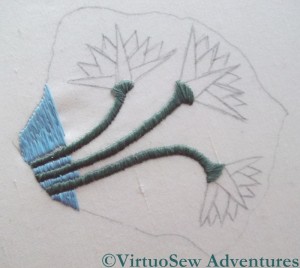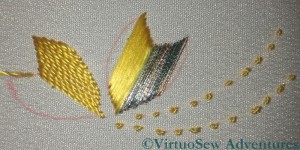Progress on the Lotus Fragment
I have chosen to work the Lotus Tile Fragment using Japanese Flat Silk, which I bought at last year’s Knitting and Stitching Show in Harrogate, from Midori Matsushima. This is rather an adventure, because I have never used flat silk before, except when I experimented with one of Stef Francis’s overdyed flat silks.
Suddenly, therefore, it rather matters to me whether I produce the effect I’m looking for, which was not the case with the Experimental Seahorse, entertaining and instructive though he was to do!
Last week , Susan of Plays with Needles quoted a Buddhist proverb in her blog – “When the student is ready, the teacher will appear“, and it turned out to be true for me too. Entirely by accident, I discovered that Midori would be teaching an introductory workshop in Japanese Embroidery techniques, not fifteen minutes’ drive away…
In two hours, there was only time for the merest scuttle through the techniques – making a twisted thread (we made a four-into-one), learning how to work a Japanese knot, how to stitch with the twisted thread and with the flat, untwisted silk, and finally how to use one of the fine metallic threads. As it happens, the techniques I have ended up using for the Lotus Tile Fragment are (understandably given my background) more Western than Japanese, but although I am intending to use flat silk throughout, it has already occurred to me that I might work an interesting alternate version using Japanese embroidery techniques. I just need Midori to come back and run another short workshop in s0me of the slightly less basic techniques…



Yeah, I’m so pleased that you have done a Japanese embroidery taster. I’ve have done a couple of classes with Midori, isn’t she wonderful! You have done really well. Your fondations are beautiful.
I think that you will find the basics that you learnt in that taster transfer very nicely to ‘western’ embroidery. A foundation layer is essentially satin stitch, so everything you learnt about laying a foundation applies to satin stitch. Even when I am doing ‘western’ embroidery now, I employ Japanese methods.
Being a fan of Japanese embroidery I find I am always learning. Not a lot of skill with technique but learning all the time. A master gave some classes in Adelaide and I was taken by his meditative approach. He said that all embroidery was a spiritual act and that we should still our spirit before we start. My spirit gets a bit agitated when working with flat silk.
How fortunate that you could take a class with Midori! That should inspire you to try some of what you have just learned on your lotus leaf now.
What a wonderful opportunity to learn new techniques! I love the rich gold stitches! XO-
I like the idea that a Buddhist proverb might apply to embroidery. Especially Japanese embroidery 🙂
What a lovely silken effect you get with that Japanese technique.
Japanese embroidery always looks so perfect, so rich. I am so pleased you got to take a workshop…..and I think we should share a PA. They can flit between the two of us….
I just love the way the flat silk is used in Japanese embroidery and I like the effect you’ve achieved in the lotus tile project .Looking forward to see your progress…